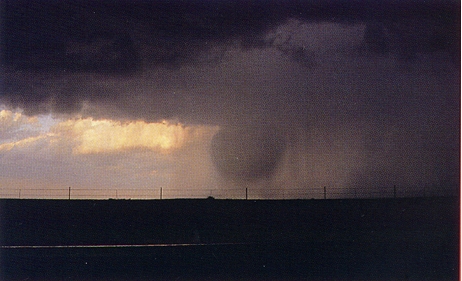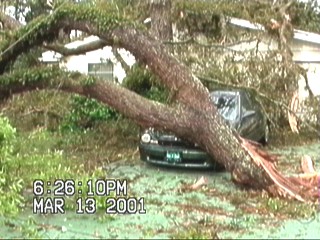| Monitor NOAA Weather Radio. |
| Listen for "Severe Thunderstorm Watches" for your county. This means that conditions are favorable for severe thunderstorms to develop. |
| Listen for "Severe Thunderstorm Warnings" for your county. This means that a severe thunderstorm is occurring or is imminent. |
| When severe thunderstorms threaten, go to a small interior room on the lowest floor of your home, school, or business. Avoid windows. |
| To improve your odds in minimizing the hazard to life or injury, follow this rule of thumb: "put as many walls between you and the outside wind." |
| In vehicles, avoid driving through severe thunderstorms. Consider pulling over or delaying travel. |
| Prior to a severe thunderstorm's arrival, move vehicles into garages or under carports to help prevent damage. Do this as time and safety permits. Bring in pets. |
| Tornadoes can also occur with severe thunderstorms. If a tornado approaches, seek shelter in an interior closet or bathroom. If possible, protect your head and body with something padded such as pillows or a small mattress. |
|

Thunderstorms are part of life in Florida. They are nature's way of supplying and distributing needed rainfall, dispersing excessive atmospheric heat, and cleaning the air of harmful pollutants. No other state in our country has more of them. The reason is simply put, all of the right ingredients to produce thunderstorms are available over Florida throughout most of our long warm season.
On average, the central Florida receive the most thunderstorms with over 90 days per year. Although the average Florida thunderstorm is less than 15 miles in diameter, they can grow vertically to great heights in excess of 10 miles into the upper atmosphere. This stacking effect of concentrated moisture can explain why a Florida thunderstorm directly overhead could produce four or more inches of rain in less than one hour while a location only a few miles away may receive just a trace.
All thunderstorms are dangerous. Every Floridian should know how to protect themselves from the hazards of thunderstorms. Lightning, tornadoes, downbursts, hail, and flooding rain are all dangerous by-products of thunderstorms that could be lethal to the unknowing and unprotected.
Severe Thunderstorms vs. Ordinary Thunderstorms
Although every Florida thunderstorm has the potential to cause injury or property damage, only about 10 percent actually produce dangerous winds or sufficiently large hail to be of a significant hazard as to result in damage to well-built structures or cause bodily harm. These are known as "severe thunderstorms". Severe thunderstorms produce hail at least the size of a dime (3/4 inch) or larger and/or gusty winds of 58 mph (50 knots) or more. The National Weather Service issues Severe Thunderstorm Warnings for particular counties (or parts of counties) when a severe thunderstorm is occurring or is imminent.
Damaging Winds & Downbursts
 Thunderstorms are capable of producing two kinds of damaging winds. The first is a tornado winds which are rotational in character. The second is downburst/gust front winds which are straight-line in character. In Florida, the occurrence of damaging downburst winds outnumber tornado winds by nearly 10 to 1 in ratio. The old adage "what goes up, must come down" holds true for the rising air in thunderstorms. A typical gusty breeze around 25 mph accompanied by a temperature drop of 10 to 20 degrees in a few minutes of time is the result of the downdraft of a nearby thunderstorm. However, at times this downdraft becomes more vigorous and can become a downburst. Downbursts winds can become severe, reaching speeds in excess of 58 mph and cause considerable damage. In extreme cases, some downburst winds can be as strong as an F2 tornado. Thunderstorms are capable of producing two kinds of damaging winds. The first is a tornado winds which are rotational in character. The second is downburst/gust front winds which are straight-line in character. In Florida, the occurrence of damaging downburst winds outnumber tornado winds by nearly 10 to 1 in ratio. The old adage "what goes up, must come down" holds true for the rising air in thunderstorms. A typical gusty breeze around 25 mph accompanied by a temperature drop of 10 to 20 degrees in a few minutes of time is the result of the downdraft of a nearby thunderstorm. However, at times this downdraft becomes more vigorous and can become a downburst. Downbursts winds can become severe, reaching speeds in excess of 58 mph and cause considerable damage. In extreme cases, some downburst winds can be as strong as an F2 tornado.
Thunderstorm Facts
- Softball-sized hail was reported with a severe thunderstorm in Lake Wales, Florida on March 30, 1996. Hail larger than a baseball was reported with a severe thunderstorm Near Orlando, Florida on March 25, 1992.
- Hail drifts, up to several feet deep of dime to nickel-sized hail, occurred in low-lying areas near Longwood, Florida on March 6, 1992 and again near Zephyrhills, Florida on January 29, 1997.
|